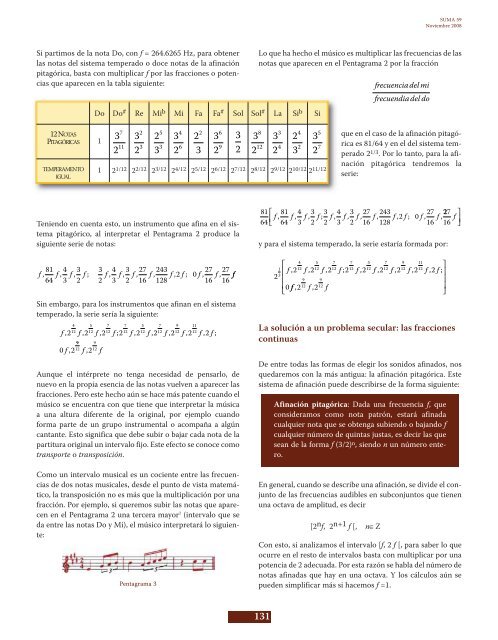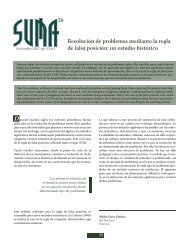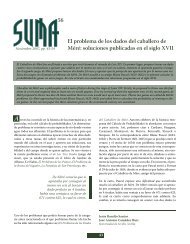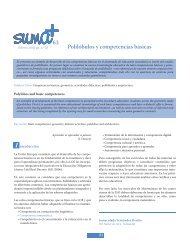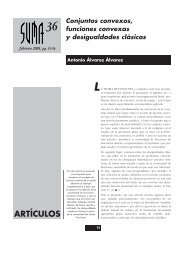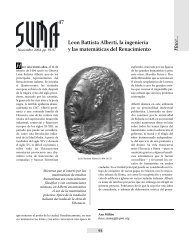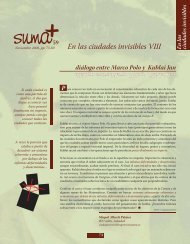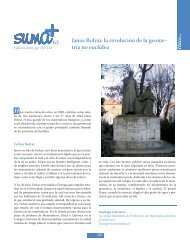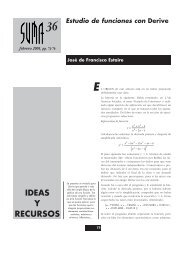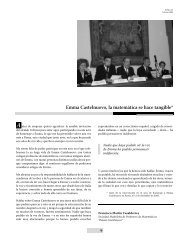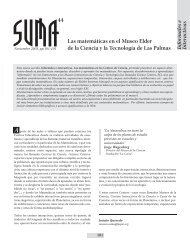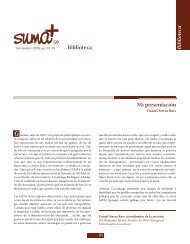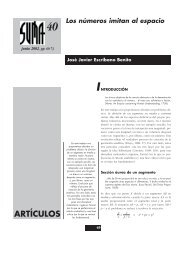Las fracciones de la Música - SUMA Revistas de matemáticas
Las fracciones de la Música - SUMA Revistas de matemáticas
Las fracciones de la Música - SUMA Revistas de matemáticas
Create successful ePaper yourself
Turn your PDF publications into a flip-book with our unique Google optimized e-Paper software.
Si partimos <strong>de</strong> <strong>la</strong> nota Do, con f = 264.6265 Hz, para obtener<br />
<strong>la</strong>s notas <strong>de</strong>l sistema temperado o doce notas <strong>de</strong> <strong>la</strong> afinación<br />
pitagórica, basta con multiplicar f por <strong>la</strong>s <strong>fracciones</strong> o potencias<br />
que aparecen en <strong>la</strong> tab<strong>la</strong> siguiente:<br />
12 NOTAS<br />
PITAGÓRICAS<br />
TEMPERAMENTO<br />
IGUAL<br />
Teniendo en cuenta esto, un instrumento que afina en el sistema<br />
pitagórico, al interpretar el Pentagrama 2 produce <strong>la</strong><br />
siguiente serie <strong>de</strong> notas:<br />
Sin embargo, para los instrumentos que afinan en el sistema<br />
temperado, <strong>la</strong> serie sería <strong>la</strong> siguiente:<br />
4<br />
12 12 12 12 12 12 12 12<br />
f, 2 f, 2 f, 2 f; 2 f, 2 f, 2 f, 2 f, 2 f, 2f;<br />
0f, 2<br />
9<br />
12<br />
5<br />
9<br />
12<br />
f, 2 f<br />
Do Do # Re Mi b Mi Fa Fa # Sol Sol # La Si b Si<br />
1<br />
7<br />
3<br />
2<br />
7<br />
11<br />
7<br />
3<br />
2<br />
Aunque el intérprete no tenga necesidad <strong>de</strong> pensarlo, <strong>de</strong><br />
nuevo en <strong>la</strong> propia esencia <strong>de</strong> <strong>la</strong>s notas vuelven a aparecer <strong>la</strong>s<br />
<strong>fracciones</strong>. Pero este hecho aún se hace más patente cuando el<br />
músico se encuentra con que tiene que interpretar <strong>la</strong> música<br />
a una altura diferente <strong>de</strong> <strong>la</strong> original, por ejemplo cuando<br />
forma parte <strong>de</strong> un grupo instrumental o acompaña a algún<br />
cantante. Esto significa que <strong>de</strong>be subir o bajar cada nota <strong>de</strong> <strong>la</strong><br />
partitura original un intervalo fijo. Este efecto se conoce como<br />
transporte o transposición.<br />
Como un intervalo musical es un cociente entre <strong>la</strong>s frecuencias<br />
<strong>de</strong> dos notas musicales, <strong>de</strong>s<strong>de</strong> el punto <strong>de</strong> vista matemático,<br />
<strong>la</strong> transposición no es más que <strong>la</strong> multiplicación por una<br />
fracción. Por ejemplo, si queremos subir <strong>la</strong>s notas que aparecen<br />
en el Pentagrama 2 una tercera mayor 2 (intervalo que se<br />
da entre <strong>la</strong>s notas Do y Mi), el músico interpretará lo siguiente:<br />
2<br />
3<br />
5<br />
Pentagrama 3<br />
2<br />
3<br />
5<br />
3<br />
7<br />
3<br />
2<br />
9<br />
4<br />
6<br />
2<br />
2<br />
3<br />
1 2 1/12 2 2/12 2 3/12 2 4/12 2 5/12 2 6/12 2 7/12 2 8/12 2 9/12 2 10/12 2 11/12<br />
81 4 3 3 4 3 27 243<br />
27 27<br />
f, f, f, f; f, f, f, f, f, 2f; 0f,<br />
f,<br />
64 3 2 2 3 2 16 128<br />
16 16 f<br />
11<br />
3<br />
2<br />
6<br />
9<br />
3<br />
2<br />
3<br />
2<br />
131<br />
<strong>SUMA</strong> 59<br />
Noviembre 2008<br />
Lo que ha hecho el músico es multiplicar <strong>la</strong>s frecuencias <strong>de</strong> <strong>la</strong>s<br />
notas que aparecen en el Pentagrama 2 por <strong>la</strong> fracción<br />
8<br />
12<br />
3<br />
2<br />
que en el caso <strong>de</strong> <strong>la</strong> afinación pitagórica<br />
es 81/64 y en el <strong>de</strong>l sistema temperado<br />
2 1/3. Por lo tanto, para <strong>la</strong> afinación<br />
pitagórica tendremos <strong>la</strong><br />
serie:<br />
y para el sistema temperado, <strong>la</strong> serie estaría formada por:<br />
2<br />
3<br />
4<br />
1<br />
3<br />
2<br />
3<br />
4<br />
2<br />
3<br />
2<br />
5<br />
7<br />
4 5 7 7 5 7 9 11<br />
⎡<br />
⎤<br />
12 12 12 12 12 12 12 12<br />
⎢ f, 2 f, 2 f, 2 f; 2 f, 2 f, 2 f, 2 f, 2 f, 2f;<br />
⎥<br />
⎢ 9 9<br />
⎥<br />
⎢ 12 12<br />
0 f, 2 f, 2 f<br />
⎥<br />
⎣<br />
⎦<br />
La solución a un problema secu<strong>la</strong>r: <strong>la</strong>s <strong>fracciones</strong><br />
continuas<br />
De entre todas <strong>la</strong>s formas <strong>de</strong> elegir los sonidos afinados, nos<br />
quedaremos con <strong>la</strong> más antigua: <strong>la</strong> afinación pitagórica. Este<br />
sistema <strong>de</strong> afinación pue<strong>de</strong> <strong>de</strong>scribirse <strong>de</strong> <strong>la</strong> forma siguiente:<br />
Afinación pitagórica: Dada una frecuencia f, que<br />
consi<strong>de</strong>ramos como nota patrón, estará afinada<br />
cualquier nota que se obtenga subiendo o bajando f<br />
cualquier número <strong>de</strong> quintas justas, es <strong>de</strong>cir <strong>la</strong>s que<br />
sean <strong>de</strong> <strong>la</strong> forma f (3/2) n, siendo n un número entero.<br />
En general, cuando se <strong>de</strong>scribe una afinación, se divi<strong>de</strong> el conjunto<br />
<strong>de</strong> <strong>la</strong>s frecuencias audibles en subconjuntos que tienen<br />
una octava <strong>de</strong> amplitud, es <strong>de</strong>cir<br />
[2 n f, 2 n+1 f [, n∈Z<br />
frecuencia<strong>de</strong>l mi<br />
frecuendia<strong>de</strong>l do<br />
81 81 4 3 3 4 3 27 243<br />
27<br />
f, f, f, f; f, f, f, f, f, 2f; 0f,<br />
f,<br />
64 64 3 2 2 3 2 16 128<br />
16<br />
27<br />
16 f<br />
⎡<br />
⎤<br />
⎢<br />
⎥<br />
⎣<br />
⎦<br />
Con esto, si analizamos el intervalo [f, 2 f [, para saber lo que<br />
ocurre en el resto <strong>de</strong> intervalos basta con multiplicar por una<br />
potencia <strong>de</strong> 2 a<strong>de</strong>cuada. Por esta razón se hab<strong>la</strong> <strong>de</strong>l número <strong>de</strong><br />
notas afinadas que hay en una octava. Y los cálculos aún se<br />
pue<strong>de</strong>n simplificar más si hacemos f =1.


